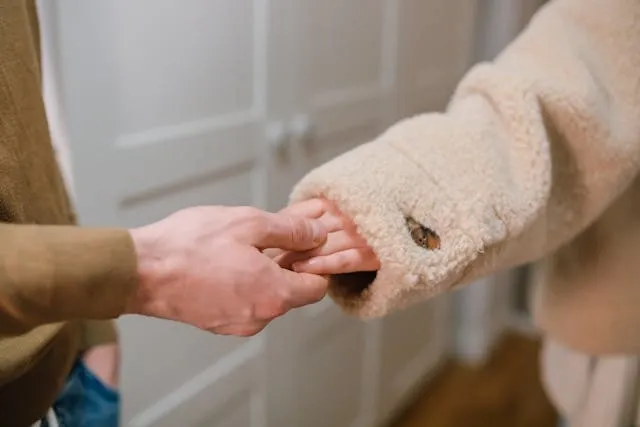Can You Put Iron-On Patches On Fleece? Tips For A Better Stick & Durability
Curious about whether you can put iron-on patches on fleece? In this post, we explore how you can achieve a stronger stick with superior durability. You will learn essential tips and techniques to ensure your patches remain firmly attached to fleece fabric.

Key Takeaways
- Iron-on patches can usually be applied to fleece, but their compatibility varies depending on the fleece type.
- Fabric glue or sewing may help achieve a secure bond on thicker fleece, as the texture may pose challenges.
- Lightweight fleece is easier to work with, but it may be more vulnerable to heat damage.
- For reliable results, use high-quality iron-on patches and follow precise application instructions.
- We supply custom iron-on patches that can be tailored to your aesthetic and practical needs to add the perfect accessory to your fleece.
Table of contents
-
Can You Put Iron-On Patches On Fleece?
-
What Are The Steps To Apply Iron-On Patches To Fleece?
-
Is Sewing Patches On Fleece A Good Alternative?
-
What Are Common Issues When Ironing Patches Onto Fleece?
-
Can You Heat Press On Fleece?
-
Can You Use Heat N Bond On Fleece?
-
Does Fleece Melt In The Dryer?
-
How Do You Remove Iron-On Patches From Fleece?
-
How Do You Iron Fusible Fleece To Fabric?
-
How Do I Care For My Fleece After Applying An Iron-On Patch?
Can You Put Iron-On Patches On Fleece?
Iron-on patches can work on fleece, but there are various types of fleece with different properties:
- Synthetic fleece: Often made from polyester, this can be challenging as the fabric is sensitive to heat and may melt during application.
- Natural fleece: Often made with cotton blends, these are generally more compatible with iron-on patches.
You may need to apply some fabric glue with thicker fleeces to achieve a secure bond, as their texture can make a strong adhesion difficult. Lightweight fleeces are usually easier to work with, but you must take extra care to avoid overheating.
We supply high-quality custom iron-on patches that you can apply to fleece with the right care and consideration.

How Does It Work?
Fleece is popular for its softness and insulating properties, and it comes in different compositions and thicknesses. Synthetic fleeces can be heat-sensitive and may deform under high temperatures, which has implications for applying iron-on patches. Natural fleeces, meanwhile, offer better heat resistance, but can be challenging because of their textured surfaces.
If you have a thick fleece, you will enjoy superb warmth and comfort, but that thickness may hinder the ability of an iron-on patch to adhere without extra glue or stitching. Lightweight fleeces are a little easier to work with, but are also more vulnerable to damage from heat exposure.
What Are The Steps To Apply Iron-On Patches To Fleece?
To iron on patches on fleece, use the following process:
- Preheat the iron to a low-medium setting for synthetic fabrics.
- Place the fleece on a flat, heat-resistant surface.
- Position the patch where you want it to go, adhesive-side down.
- Place a pressing cloth over the patch to protect the fleece from direct heat.
- Press the iron firmly onto the patch through the cloth for 15-20 seconds.
- Allow the patch to cool completely before handling.
Using a pressing cloth is crucial in how to iron on patches to fleece to prevent scorching or melting and distribute heat evenly.
What Should I Do Before Ironing A Patch Onto Fleece?
Before you iron a patch onto a fleece, do the necessary preparation:
- Clean the fleece: A clean, dry surface is important for optimal adhesion.
- Arrange the patch: Choose the patch positioning carefully and ensure it is properly aligned.
- Preheat the area: Gently preheat the application area with your iron to smooth out wrinkles.
- Use a pressing cloth: This is absolutely essential to shield the fleece from direct contact with the hot iron.
With these steps, you ensure a smooth, secure bond when you move onto applying the patch.
What Are Some Tips For Successful Application Of Iron-On Patches On Fleece?
To successfully apply iron-on patches on fleece, follow these general tips:
- Avoid steam: Use a dry iron, as steam can weaken the adhesive and undermine the bond.
- Consistent pressure: Apply firm pressure evenly over the patch for the recommended time.
- Test first: Apply heat to a small, inconspicuous area of the fleece to test whether it tolerates it.
- Manufacturer instructions: Closely follow the patch instructions for best results.
- Pressing cloth: Protect the fleece from direct heat with a pressing cloth or parchment paper.
- Preheat area: Gently heating the application area will smooth out wrinkles and aid adhesion.
Explore custom iron-on patches possibilities
Though not the best option for fleece material, our custom iron-on patches can be reinforced with some stitches to achieve a strong attachment and display your vibrant design with flair.
Is Sewing Patches On Fleece A Good Alternative?
Learning to sew a patch on is a good alternative to ironing. With sewing, you get a more secure and durable attachment, particularly on awkward materials like thick fleece. Sewing, or using fabric glue, could also be excellent solutions to reinforce an iron-on patch for a stronger adhesion.
You will need to choose a matching thread and a needle that is suitable for your fleece fabric. Stitch tightly around the edges of the patch with a straight stitch or zigzag stitch for maximum hold. This approach is certain to achieve a lasting bond, even with frequent wear and washing.
What Are Common Issues When Ironing Patches Onto Fleece?
There are various common issues people encounter when using iron-on patches on fleece. The most common are that patches don’t stick, or that they start to peel off soon after application. Here are some tips to help prevent this:
- Ensure the fleece is clean and dry before application.
- Use a pressing cloth or parchment paper to help distribute heat.
- Set the iron to a low-medium temperature and avoid steam.
- Apply firm, consistent pressure for the recommended time.
- Reinforce with fabric glue or stitching around the edges.
Our custom designer iron-on patches are designed to achieve a strong bond, and following best practices should help get it right.

Why Won't My Iron-On Patches Stick On Fleece?
There can be several causes to the issue of iron-on patches not attaching to a fleece. Most commonly, the problem is that the textured surface inhibits the adhesion. It may help to ensure the fleece is clean and dry before application. The problem may also be that the iron temperature is not right, so try increasing it slightly and turning off the steam.
Pressing for an insufficient time or failing to apply enough pressure could also cause the problem. It might help to use a pressing cloth to distribute heat evenly. If none of this helps, you might need to try a different patch type like a sew-on one.
Do Iron-On Patches Stay On Fleece Long-Term?
You may find that iron-on patches don’t stay on fleece long-term due to the textured surface and flexibility of the fabric. These impede proper adhesion, even if the initial bond seems secure. You will need to take extra care when wearing and washing your fleece, and it might be necessary to reinforce the patch with some stitching around the edges to enhance its longevity.
If you want to be truly confident you have a long-lasting addition to your fleece, we recommend opting for sew-on patches instead. These will deliver maximum strength and durability in their attachment.
Want a temporary attachment for your fleece?
With our custom adhesive patches, you can enjoy the premium aesthetic with a custom peel-and-stick attachment that is simple to apply and remove as you need.
Create your patches hereCan You Heat Press On Fleece?
Heat pressing can be a great way to apply iron-on patches without an iron when working with fleece. This method provides more consistent heat and pressure, evenly distributing the warmth to help achieve a stronger bond between the patch and fleece. This method is particularly effective for larger patches or bulk applications.
The problem is that it requires a dedicated machine that is not a common household item. You will also need to take extra care when adjusting the temperature and pressure settings to prevent overheating - something you can control manually with an iron. Overall, you are likely to achieve superior results when using a heat press over an iron.
Can You Heat Press On Sherpa Fleece?
With careful consideration, you can use a heat press on Sherpa fleece. The fluffy texture of the fabric means you will need to use a low temperature setting to avoid flattening or damaging the fabric. Use a pressing cloth or parchment paper between the heat press and the Sherpa fleece to add protection while helping with even what distribution.
The pressure should be relatively gentle, and you should carefully check the care instructions for temperature recommendations for the Sherpa fabric. With diligence and attention to temperature and pressure, you can successfully use a heat press to apply iron-on patches to Sherpa fleece for great results.
Can You Heat Press On A Fleece Blanket?
It is possible to iron-on patches to a fleece blanket using a heat press. You should lay the blanket flat on the heat press bed with a pressing pillow underneath to ensure even pressure. Adjust the temperature and time settings of the heat press according to the fabric type and patch instructions.
Blankets are large items, so you may need to use a larger heat press or work in sections if you are applying more than one patch. Again, a pressing cloth or parchment paper can help protect the fleece and ensure even heat distribution. This method ensures a durable application.
Can You Use Heat N Bond On Fleece?
Heat N Bond can be effective on fleece. It is a type of adhesive web that bonds fabrics together with the application of heat. It can work well with fleece, providing a strong, durable bond that can complement your custom name iron-on patches. If you use Heat N Bond, you get superior versatility in application versus just using an iron-on patch by itself.
Working with the adhesive requires careful heat application and pressure to optimize the bond. When used correctly, Heat N Bond is a reliable alternative to attach patches or other fabrics to fleece with a secure, long-lasting bond.
Enjoy a removable, replaceable custom patch solution
Fleece material can work well with our custom Velcro patches, which can be easily added and removed for any purpose with no compromise on design aesthetic.
Does Fleece Melt In The Dryer?
Generally speaking, fleece is heat-sensitive and could become deformed if exposed to high temperatures in a dryer. You should carefully follow the specific guidelines of your product for safe care. Lower heat settings are safest when drying a fleece to prevent damage to the fabric.
Similarly, when ironing fleece, stick to low heat settings and avoid direct contact with the hot iron to avoid scorching. For maximum safety, consider air drying your fleece instead of putting it into the tumble dryer. By taking these simple precautions, you can preserve the softness and integrity of fleece fabric to preserve your garment’s quality over time.
Will An Iron Melt Fleece?
An iron set to a high temperature can potentially damage a fleece. The heat-sensitive fabric needs to be ironed at lower heat settings to prevent melting or scorching. It is wise to test the iron on a small, inconspicuous area of the fleece first before applying heat to the entire fabric.
It may be prudent to place a pressing cloth over the fleece and iron on the reverse side to minimize the risk of damage. This will also help distribute heat evenly whilst shielding the fabric from direct heat exposure. These precautions will enable you to iron fleece safely.
How Do You Remove Iron-On Patches From Fleece?
To remove iron-on patches from fleece, the first step is to heat the patch with a hot iron on the cotton setting. You should put a pressing cloth on top of the patch to protect the fleece fabric and apply pressure for 10-15 seconds. Once this is done, use tweezers or a flat tool to gently lift and peel the patch away.
Continue applying heat and gently peeling until the patch comes off. You could try using a hair dryer to heat the patch if you don’t want to use an iron. Clean away residue left by the adhesive with rubbing alcohol or an adhesive remover. Your main focus should be on avoiding damaging the fleece as you remove the patch.
Choose a popular patch material for your fleece
Our custom embroidered patches can be crafted with iron-on or various other backings to add an iconic embellishment that can attach to your fleece securely.
Make a startHow Do You Iron Fusible Fleece To Fabric?
Iron fusible fleece to fabric by preheating your iron to the temperature the manufacturer recommends. Place the fusible side of the fleece against the wrong side of your fabric, and cover with a pressing cloth before applying firm pressure with the hot iron for 10-15 seconds per section.
Fusible fleece is not the same thing as a traditional iron-on patch. Its purpose is to add structure or padding to your projects. It adds a softer, quilted effect when adhered to a piece of fabric.

How Do I Care For My Fleece After Applying An Iron-On Patch?
After you apply an iron-on patch to fleece, you must care for it properly to preserve its integrity. Turn the fleece inside out before putting it in the wash to protect both the patch and the fabric. Always use cold water and a gentle cycle to keep agitation to a minimum, and avoid fabric softeners and harsh detergents.
After washing, we recommend air drying to avoid excessive heat exposure. Follow the specific care instructions provided with your patch for best results. When you order from us, you get high-quality custom patches and detailed guidance on how to maximize their longevity.
Frequently Asked Questions About Can You Put Iron-On Patches On Fleece
Can You Iron On Patches To Fleece?
Yes you can, but it may be challenging to get a strong adhesion. You will need to be mindful of the temperature and pressure, and it might be necessary to reinforce the attachment with sewing or fabric glue.
Can You Sew Patches Onto Fleece?
Of course! This is probably the best method for attaching patches to fleece, because it doesn’t involve exposing the fabric to heat and will achieve a robust, consistent bond that stands the test of time.